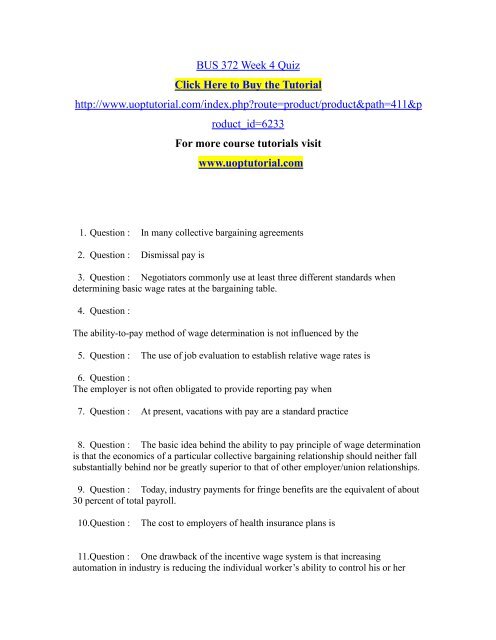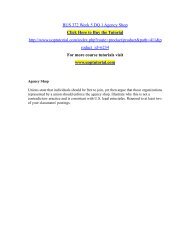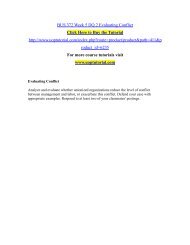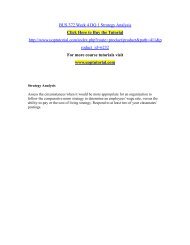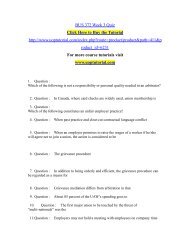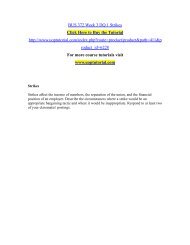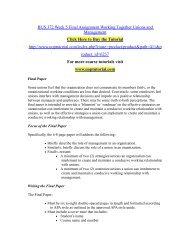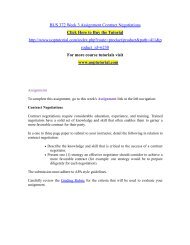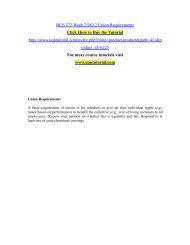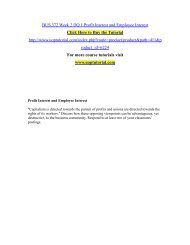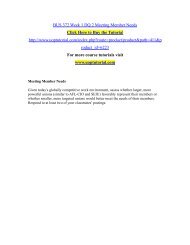BUS 372 Week 4 Quiz
For more course tutorials visit www.uoptutorial.com 1. Question : In many collective bargaining agreements 2. Question : Dismissal pay is 3. Question : Negotiators commonly use at least three different standards when determining basic wage rates at the bargaining table. 4. Question : The ability-to-pay method of wage determination is not influenced by the 5. Question : The use of job evaluation to establish relative wage rates is 6. Question : The employer is not often obligated to provide reporting pay when 7. Question : At present, vacations with pay are a standard practice 8. Question : The basic idea behind the ability to pay principle of wage determination is that the economics of a particular collective bargaining relationship should neither fall substantially behind nor be greatly superior to that of other employer/union relationships. 9. Question : Today, industry payments for fringe benefits are the equivalent of about 30 percent of total payroll. 10.Question : The cost to employers of health insurance plans is 11.Question : One drawback of the incentive wage system is that increasing automation in industry is reducing the individual worker’s ability to control his or her own output. 12.Question : Non-wage economic benefits should not be considered part of a firm’s total wage bill because these are indirect payments and therefore do not cost a firm as much as direct payments.
For more course tutorials visit
www.uoptutorial.com
1. Question : In many collective bargaining agreements
2. Question : Dismissal pay is
3. Question : Negotiators commonly use at least three different standards when determining basic wage rates at the bargaining table.
4. Question :
The ability-to-pay method of wage determination is not influenced by the
5. Question : The use of job evaluation to establish relative wage rates is
6. Question :
The employer is not often obligated to provide reporting pay when
7. Question : At present, vacations with pay are a standard practice
8. Question : The basic idea behind the ability to pay principle of wage determination is that the economics of a particular collective bargaining relationship should neither fall substantially behind nor be greatly superior to that of other employer/union relationships.
9. Question : Today, industry payments for fringe benefits are the equivalent of about 30 percent of total payroll.
10.Question : The cost to employers of health insurance plans is
11.Question : One drawback of the incentive wage system is that increasing automation in industry is reducing the individual worker’s ability to control his or her own output.
12.Question : Non-wage economic benefits should not be considered part of a firm’s total wage bill because these are indirect payments and therefore do not cost a firm as much as direct payments.
- No tags were found...
Create successful ePaper yourself
Turn your PDF publications into a flip-book with our unique Google optimized e-Paper software.
<strong>BUS</strong> <strong>372</strong> <strong>Week</strong> 4 <strong>Quiz</strong><br />
Click Here to Buy the Tutorial<br />
http://www.uoptutorial.com/index.php?route=product/product&path=411&p<br />
roduct_id=6233<br />
For more course tutorials visit<br />
www.uoptutorial.com<br />
1. Question : In many collective bargaining agreements<br />
2. Question : Dismissal pay is<br />
3. Question : Negotiators commonly use at least three different standards when<br />
determining basic wage rates at the bargaining table.<br />
4. Question :<br />
The ability-to-pay method of wage determination is not influenced by the<br />
5. Question : The use of job evaluation to establish relative wage rates is<br />
6. Question :<br />
The employer is not often obligated to provide reporting pay when<br />
7. Question : At present, vacations with pay are a standard practice<br />
8. Question : The basic idea behind the ability to pay principle of wage determination<br />
is that the economics of a particular collective bargaining relationship should neither fall<br />
substantially behind nor be greatly superior to that of other employer/union relationships.<br />
9. Question : Today, industry payments for fringe benefits are the equivalent of about<br />
30 percent of total payroll.<br />
10.Question :<br />
The cost to employers of health insurance plans is<br />
11.Question : One drawback of the incentive wage system is that increasing<br />
automation in industry is reducing the individual worker’s ability to control his or her
own output.<br />
12.Question : Non-wage economic benefits should not be considered part of a firm’s<br />
total wage bill because these are indirect payments and therefore do not cost a firm as<br />
much as direct payments.


